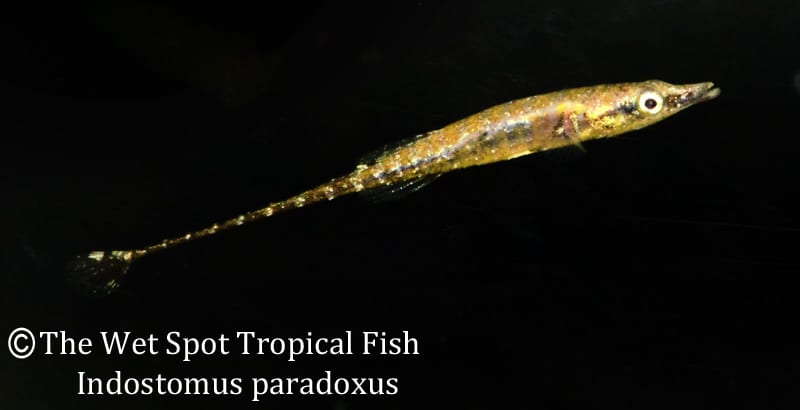Gravity Waves Goodbye
Gravity Waves Goodbye
| A legend in his own lifetime, the extraordinary Stephen Hawking will remain one far beyond his years, as his ingenuity in the fields of cosmology and physics is unparalleled. Scientists are not alone in mourning his loss this month; a great many are lamenting his sudden absence. With his incredible intellect and passion for science, Stephen Hawking effectively introduced fundamental concepts of how our universe ‘ticks’ to the masses. We offer a humble tip of our hats to his accomplishments this week, as we highlight some of his works through the lens of these aquarium favorites: Macropodus spechti, Indostomus paradoxus, and Botia kubotai. |
Scientific NameMacropodus spechti
Common NameBlack Paradise Fish
Temperature / pH70 to 86°F / 6.0 to 8.0 pH
Native LocationSoutheast Asia/Indonesia
Preferred DietSmall invertebrates
Instrumental in forming our understanding of how black holes “behave”, Hawking was the first to show that “quantum field theory” predicts black holes create and emit particles, now known as “Hawking radiation”. A different sort of “black body”, but equally beautiful and mysterious, M. spechti is found swimming through the irrigation ditches, marshes, pools, and rice paddies of Southeast Asia and Indonesia. More commonly known as “Black Paradise Fish”, these beauties reach about 3 inches in length, and are black-bodied with elegant, undulating dark blue fins. That is, with the exception of their ventral fins, which are bright orange as the sun. Best maintained in fully decorated aquaria, they appreciate dense vegetation including floating plants, driftwood, roots and branches placed to form dark refuges, and leaf litter. These paradise fish have peaceful temperaments and may be kept in suitable community tanks with species not tempted to nip at their long fins. Bubble nesters by nature, they are relatively easy to spawn and can be kept in pairs or larger groups (they exhibit some fun social interactions in groups of 5 or more). Mostly preying on insect larvae in the wild, they are easily fed small live or frozen foods in captivity. Over time, they may learn to accept high-quality dried products.
Scientific NameIndostomus paradoxus
Common NameParadox Toothpick Fish
Temperature / pH71 to 81°F / 6.5 to 7.5 pH
Native LocationMyanmar
Preferred DietSmall invertebrates
Unconstrained by laws governing his fields of study, Hawking put forth more than one hypothesis that seemed to contradict everything physicists knew. The “black hole information paradox” is one such example. It predicts that any physical information entering a black hole will permanently cease to exist, evaporating as “Hawking radiation”. A seemingly paradoxical fish species, named for its contrary appearance, I. paradoxus somehow manages to swim with toothpick bodies among riparian vegetation and leaf litter in standing waters of Myanmar. Reaching just over 1 inch in length, the “Paradox Toothpick Fish” is thin, pointed, and armored with spines. Faring best in well planted setups, tanks should be equipped with soft substrate, leaf litter, low light filtered through floating plants, and plenty of dark refuges formed from furnishings like driftwood or long plastic piping. Very peaceful by nature, these small fish, however, are not ideal for community tanks. Often predated upon and poor competitors, they should only be kept alongside similarly-sized, calm species like Boraras, Danionella, or Dario. They also seem to do best in captive settings with conspecific cohorts of at least 4 individuals. Feeding on miniscule invertebrates, zooplankton, and insect larvae in the wild, they will only accept small live foods like Artemia, Daphnia, or micro-worm. Mature, planted aquaria will additionally give way to microfauna as a food source.
Scientific NameBotia kubotai
Common NameBurmese Border Loach
Temperature / pH72 to 82°F / 6.0 to 7.5 pH
Native LocationMyanmar/Thailand
Preferred DietOmnivorous
An avid supporter of the “many worlds interpretation” of quantum mechanics, Hawking postulated that all possible past and future outcomes are real, each existing in their own reality or universe. Just as his mind imagined the borders of these possible universes, B. kubotai minds the border of Myanmar and Thailand. These “Burmese Border Loaches” reach up to 6 inches in length, and have dark bodies sporting constellations of light blotches. Having an affinity for forested, slow-moving regions of well-oxygenated headwaters, they are found amongst mixed sand and rock substrate, submerged driftwood, and leaf litter. Like any botiid, they require well-structured tank setups with sandy substrate, smooth rocks and pebbles, driftwood, any other ornamental furniture with absolutely no sharp edges, and low lighting. Plants that thrive in low light like java fern are also encouraged. Prone to jumping, tanks should also have tight-fitting lids. Large and active, they are puppies of the trade. That means they intimidate many possible community tank-mates. Guppies, Betta, and cichlids with long fins should be specifically avoided, as they may get nipped at. Suitable tank-mates include Barrilus, Luciosoma, Balantiocheilos, or Barbonymus species. Additionally, they are gregarious by nature, and should be kept in conspecific groups of 5 or more. Feeding predominantly on mollusks, insects, worms, and other invertebrates in nature, they will also consume plant matter including soft-leaved aquatic plants. In captivity they should be fed well-rounded diets composed of live and frozen fare, small amounts of fresh fruits and veggies, and homemade gelatin-bound foods.
| The daunting task of paying tribute to the late, great Stephen Hawking was not undertaken lightly. We recognize the importance of wide-spread science education, especially under the auspices of something you know and love. If even just one of our readers appreciates his contributions a little bit more from this tribute, we’ll consider it a job well done! Suffice it to say, the world is better for having had Stephen Hawking. We feel for any universe where he was not, and envy those where he still is. |


